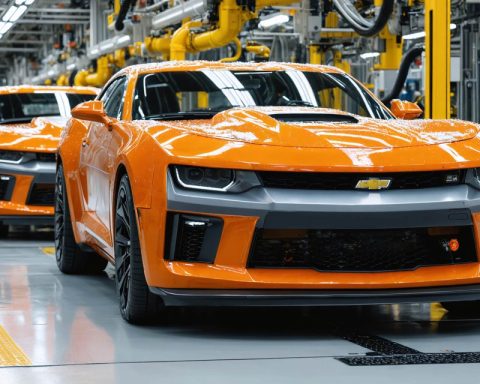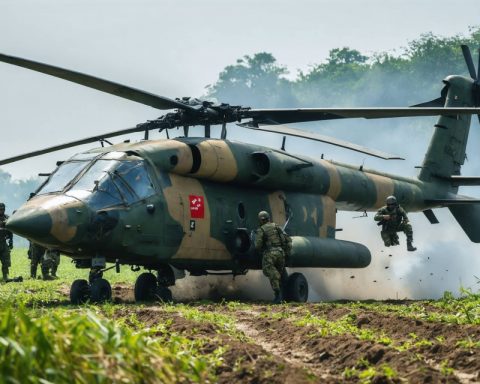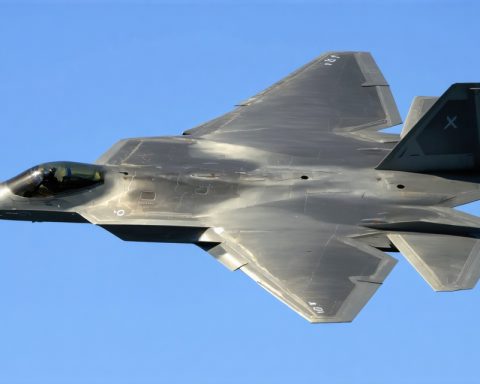- India may join the exclusive group of F-35 fighter jet operators, reflecting deepening US-India military ties.
- Elon Musk argues for the obsolescence of manned jets amid the rise of drones, challenging traditional military aviation.
- The F-35 is praised for its strategic impact but criticized for high costs and technical challenges.
- Experts like Mauro Gilli highlight the F-35’s role in shifting adversarial defense strategies.
- The F-35 debate represents a pivotal choice between established military power and emerging drone technology.
- India faces a critical decision impacting the future landscape of warfare and defense.
As geopolitical tensions simmer, the skies above India may soon witness the sleek silhouette of America’s prized F-35 fighter jet. Recently, President Trump signaled a seismic shift in US-India military cooperation, eyeing India’s inclusion in the elite club of nations operating this cutting-edge aircraft. Beneath the diplomatic euphoria, a high-stakes debate unfolds—one that pits tradition against the future.
Enter Elon Musk, tech pioneer and visionary, who challenges the very essence of manned aerial supremacy. In an era where drones stealthily navigate their own skies, Musk argues that these mighty jets—icons of advanced stealth and intelligence—may have outlived their prime. To him, the future belongs to drones, rendering manned fighter aircraft obsolete relics of risk and redundancy.
The F-35, designed to be the crown jewel of aerial warfare, faces scrutiny for its steep costs and occasional technical quirks. Critics underscore its demanding design as a cumbersome “jack of all trades,” questioning its efficacy under the glare of evolving drone technology. Meanwhile, seasoned experts like Mauro Gilli underscore the strategic leverage the F-35 commands, emphasizing its role in compelling adversaries to rethink their defense strategies.
For all its technical feats, some view the F-35 as a litmus test—a transformative force recalibrating military doctrines, pushing adversaries to the strategic drawing board. Yet, the lingering question remains: In the dance of drones and manned jets, who will ultimately dominate the skies?
In essence, the debate reveals a fork in the road for military evolution: the tried-and-true versus the untested future. As India contemplates the acquisition, it must weigh timeless tactical power against the insistent march of innovation. The ultimate choice may well redefine the contours of modern warfare.
The Future of Aerial Combat: F-35 Versus Drones – Who Will Win the Skies?
The F-35: Features, Specs & Pricing
The F-35 Lightning II is a family of stealth multirole fighters, boasting features like advanced stealth, agile combat performance, advanced sensors, and network-enabled operations. Key specifications include:
– Variants: F-35A (CTOL), F-35B (STOVL), F-35C (carrier-based).
– Engine: Pratt & Whitney F135.
– Speed: 1,200 mph (Mach 1.6).
– Range: Over 1,350 miles.
– Armament: A variety of missiles, bombs, and a 25mm cannon.
The cost of an F-35 can range from $80 million to $130 million per unit, depending on the variant and additional customizations. The operating cost is approximately $36,000 per flight hour.
Drones: Real-World Use Cases and Benefits
Drones offer a different approach with benefits that include lower costs, reduced risk to pilots, and advanced surveillance capabilities. They are increasingly used for:
– Reconnaissance: Providing real-time intelligence and surveillance.
– Combat Support: Airstrikes in precision-targeting operations, such as Predator and Reaper drones.
– Supply Delivery: Automated transport of critical supplies to difficult-to-reach locations.
– Maritime Patrol: Monitoring vast oceanic expanses with endurance and effectiveness.
Reviews & Comparisons
F-35 Reviews:
– Pros: Top-tier stealth capabilities, multirole flexibility, integrated electronic warfare, interoperability with international forces.
– Cons: High maintenance cost, ongoing software issues, initial controversies regarding performance and cost overruns.
Drone Reviews:
– Pros: Cost-effective, minimized risk to human life, long endurance, rapid development cycle.
– Cons: Vulnerability to hacking, limited capabilities compared to manned aircraft in complex combat scenarios.
Controversies & Limitations
The F-35 program has been criticized for its high costs, delays, and technical setbacks. Detractors argue these drawbacks may not justify its deployment, especially when drones can execute many functions at a fraction of the cost.
Conversely, drone reliance presents security concerns, such as vulnerability to cyber-attacks and ethical issues surrounding autonomous combat decisions.
Market Forecasts & Industry Trends
The global military aircraft market is projected to grow with an increased emphasis on multirole fighters, such as the F-35, and an expanding role for drones in combat. Industry trends indicate a dual-track approach, integrating both manned and unmanned platforms for future conflicts.
Security & Sustainability
The F-35 includes advanced cybersecurity measures to protect against electronic threats. It also incorporates sustainable technologies, such as optimized fuel usage and reduced carbon emissions during operations.
Insights & Predictions
Experts predict a continued dual-role advancement, with manned aircraft like the F-35 coexisting alongside drones. The decision for countries like India will lean on today’s geopolitical demands and their trajectory towards a well-rounded aerial defense strategy.
Tutorials & Compatibility
For countries considering acquisition:
1. Assess National Needs: Determine strategic objectives and whether manned or unmanned aircraft align with these goals.
2. Review Budgets: High costs require comprehensive financial analysis and long-term planning.
3. Technical Training: Integration requires rigorous pilot and technical training programs.
Pros & Cons Overview
F-35 Pros:
– Cutting-edge stealth technology
– Multirole versatility
– Strong deterrence factor
F-35 Cons:
– High acquisition and maintenance costs
– Complex operational requirements
– Initial tech issues
Drone Pros:
– Low-risk deployment for human personnel
– Economical operations
– Capability for extended missions
Drone Cons:
– Susceptible to cyber threats
– Limited in high-intensity conflicts
– Ethical and legal challenges
Actionable Recommendations and Quick Tips
1. Technology Assessment: Engage military strategists and technology experts to evaluate competition and complementarities of F-35 and drones in specific defense landscapes.
2. Stakeholder Collaboration: Work with allied nations operating similar systems to leverage support and developments.
3. Defense Policy Resilience: Foster agile defense policies that can adapt to technological shifts and battlefield dynamics.
For more insights into these technologies and defense strategies, visit Lockheed Martin.
In summary, while the elegance of the F-35 and the innovations of drone technology are both alluring, the ultimate choice demands not only evaluations based on capabilities and costs but also a consideration of future warfare paradigms.







